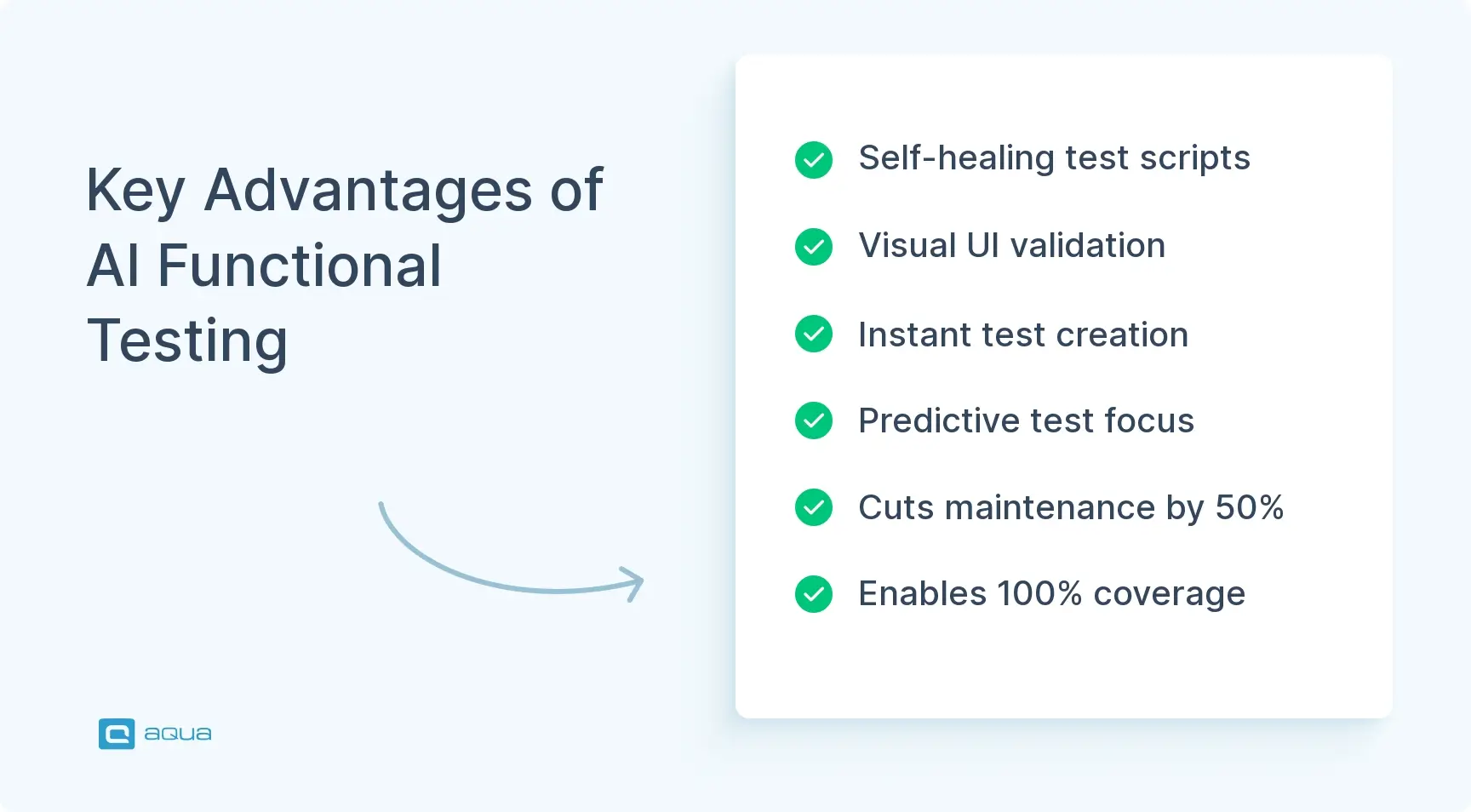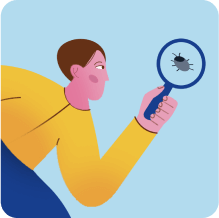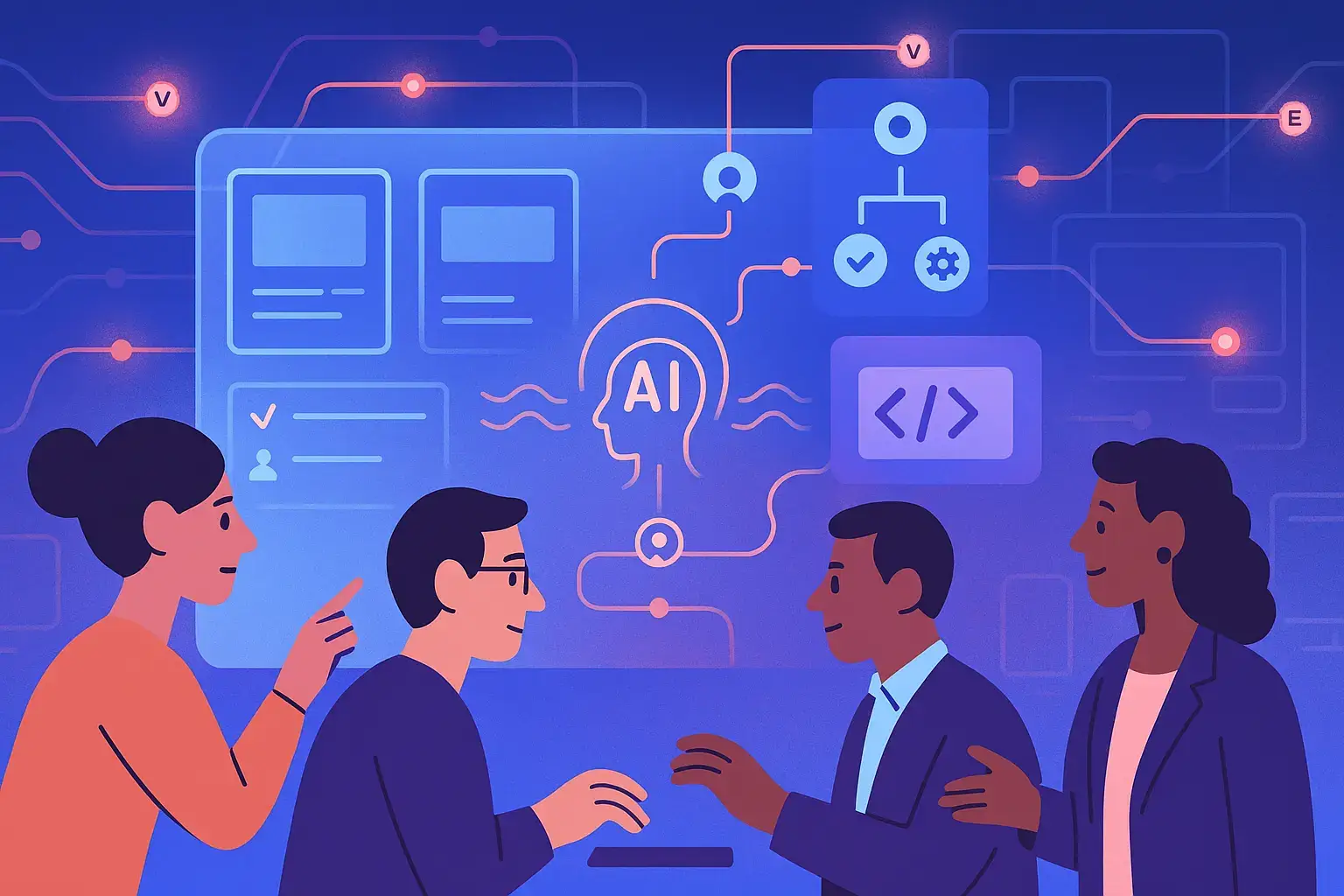What is AI-powered Functional testing?
Functional testing verifies that software behaves according to specified requirements from an end-user perspective. It focuses on user workflows, business logic, and system interactions rather than internal code structure. Traditional functional testing relies on manually written test scripts or recorded user interactions.
AI-driven functional testing applies the same core principles as traditional functional testing, but uses AI to improve speed, scale, and efficiency.
The Importance of AI-powered Functional Testing
Manual testing still has its place. But if you’re relying on it alone in 2025, you’re working with one hand tied behind your back. The pace of software development today demands something faster, broader, and more scalable. So AI enhances traditional functional testing through several key capabilities:
Intelligent Test Generation: AI analyses application behavior, user flows, and requirements to automatically create comprehensive test scenarios. It reduces the time needed to achieve broad coverage.
Self-Healing Test Maintenance: When UI elements change locations or properties, AI-powered tools can automatically update test scripts. It significantly reduces the maintenance burden that typically consumes 30-40% of QA team resources.
Visual and Behavioral Validation: Beyond checking DOM elements, AI can validate what users actually see and experience. It catches visual regressions and UX issues that traditional automation might miss.
Predictive Test Prioritisation: AI analyses code changes, historical defect patterns, and usage data to determine which tests are most likely to reveal issues. This helps with optimising testing efficiency.
The goal isn’t to eliminate human judgment from testing, but to free QA professionals from repetitive tasks. This allows them to focus on complex scenarios, edge cases, and strategic quality decisions.
Take Spotify. Their engineering teams run over 300,000 test cases every day across platforms. That level of coverage would be impossible without AI-powered automation; it would take hundreds of testers working full-time. So their team, just like any other team doing testing at scale, needs AI’s superpowers to increase their efficiency. Numbers don’t lie; according to a recent study by Capgemini, organisations using AI for functional testing found 37% more defects and reduced test maintenance by nearly half.

How AI-powered Functional Testing Differs from Conventional Automation
Now we should distinguish these two approaches. While both aim to automate your functional testing, they work in fundamentally different ways that affect how you and your team create, maintain, and run tests.
How You Create Tests: With traditional automation, you or your developers need to write test scripts from scratch: usually in JavaScript, Python, or similar languages. Every user scenario requires you to code specific element selectors and step-by-step instructions. If you want to test a login flow, you’re writing explicit code to find the username field, enter data, click buttons, and verify results.
With AI-powered testing, you can often just describe what you want to test in plain English, or let the AI explore your application and discover test scenarios automatically. Instead of coding “find element by ID ‘username-input'”, you might simply write “user logs in with valid credentials.”
What Happens When Your UI Changes: A scenario probably all QAs relate to: you update a button label or move an element, and suddenly dozens of your automated tests break. With traditional automation, you’re stuck manually updating element locators and test logic every time your developers make UI changes.
AI-powered tests heal themselves when your interface changes. They use visual recognition and smart pattern matching to find elements even when their technical properties shift, so your tests keep running without constant babysitting.
Who Can Actually Write Tests: Traditional automation often creates a bottleneck on your team. Only developers or technically skilled QA engineers can write and maintain the test scripts, leaving your domain experts and manual testers out of the automation process.
AI tools let your entire team contribute. Your product managers can describe user scenarios, your manual testers can create tests through visual interfaces, and your business analysts can turn requirements directly into automated tests—no programming required.
How Much You Can Actually Test: With traditional automation, you’re usually limited to testing the scenarios you explicitly thought of and had time to code. You test the happy paths and maybe a few edge cases you remembered to include.
AI-powered testing can uncover test scenarios you didn’t think of by analysing how real users actually interact with your application. It might discover unusual navigation paths or state combinations that your team would never have considered testing manually.
Traditional automation also struggles with dynamic content and complex workflows. For example, testing an e-commerce checkout with multiple payment methods, shipping options, and user types becomes exponentially more complex. Each new feature multiplies the number of test cases needed for reliable coverage.
While traditional functional testing frameworks are struggling with flaky tests, maintenance burdens, and limited coverage, AI-powered solutions are changing the game. aqua cloud is at the front of this revolution, offering AI-driven test management that can transform your QA process in seconds, not weeks. With aqua’s AI Copilot, you can instantly create comprehensive test cases from requirements and verify coverage gaps automatically, addressing the exact pain points mentioned earlier. Unlike basic automation tools, aqua provides intelligent test creation with context-aware test design techniques like Boundary Value Analysis and Equivalence Partitioning built right in. Teams using aqua report saving up to 12.8 hours per week per tester while achieving the 100% test coverage that traditional methods struggle to deliver. Also it integrates with your automation frameworks like Selenium, Jenkins, Ranorex, and turns them into a superpower. Why spend nearly half your time maintaining brittle test suites when AI can do the heavy lifting?
Save 98% of time spent on test case creation with aqua's AI capabilities
Integrating AI Functional Testing in Your Workflow
1. Evaluate your current setup
Start with a reality check. Where are your tests falling short? Are flaky tests slowing releases? Are you buried in maintenance? Knowing your pain points helps you focus on the right improvements.
2. Choose a tool that fits your workflow
The AI testing tool market has exploded in recent years, with dozens of platforms offering different approaches to intelligent test automation. Rather than an exhaustive comparison, here are six established platforms that represent different strengths and use cases, based on their market adoption, feature sets, and team feedback from the testing community.
Before evaluating specific tools, consider your team’s priorities:
- Do you need low-code/no-code capabilities for non-technical team members?
- Is visual testing (UI regression detection) a primary concern?
- How important is natural language test creation?
- Do you need cross-platform or mobile testing capabilities?
- What’s your existing tech stack and integration requirements
Representative AI Testing Platforms:
- Testim – Specialises in web UI testing with visual element recognition and low-code test creation, making it accessible for teams with mixed technical skills
- Mabl – Focuses on end-to-end testing with integrated visual validation and performance monitoring, popular with teams wanting comprehensive test coverage
- Applitools – Industry leader in AI-powered visual testing and cross-browser compatibility validation
- Functionize – Emphasises natural language test authoring, allowing business users to write tests in plain English
- TestCraft – Designed for teams new to AI testing, offering intuitive interfaces and quick setup
- Eggplant – Enterprise-focused platform with strong multi-platform support and advanced analytics
Evaluation approach: Schedule demos with 2-3 platforms that match your primary needs. Most vendors offer free trials or proof-of-concept periods that let you test with your actual application.
3. Start with a pilot
Choose one stable, well-understood feature. Run both traditional and AI-powered tests in parallel so you can compare results and understand the gains.
4. Upskill your team
Even low-code tools need context. Give your team time to learn the new system, especially how it integrates into your workflows and CI/CD.
5. Connect it to your pipeline
Loop in your DevOps team to hook the AI testing tool into your CI/CD. It should run automatically with every commit or deployment.
6. Measure what matters
Track practical metrics, not vanity ones. Focus on:
- Time to write new tests
- Hours spent on maintenance
- Bugs caught before release
- Total test coverage
- Execution time across platforms
Quick checklist
- Identify test pain points
- Evaluate 2–3 AI testing platforms
- Run a small pilot project
- Train 1–2 team members deeply
- Set up CI/CD integration
- Track key metrics from day one
- Expand gradually based on results
AI testing isn’t a magic switch. But with the right setup, it can save serious time, catch more bugs, and make your team’s job a lot easier.
Future Trends in AI Functional Testing
AI is already changing how we do functional testing, but the most impactful changes are just getting started. Here’s what’s on the horizon:
Plain language turns into test logic
Instead of writing scripts, teams will soon describe user flows in plain English. Something like “The user logs in, updates their profile, and logs out” could become a full test case. No coding required.
Smarter test targeting
AI won’t just help run tests, it will help choose the right ones. Based on code changes, usage data, and past bugs, it’ll point out exactly where things are most likely to break. That means less testing with better results.
Test creation without the setup
Some tools will crawl your app like a user and automatically generate functional test cases. It’s already happening in controlled cases. In the future, this will cover complex workflows with no manual configuration needed.
Instant functional testing environments
Setting up test environments and pipelines will get easier. Cloud-based platforms will spin up everything you need on the fly, run the right AI-powered functional tests, and give results, all in one place.
Functional tests that think visually
Tests won’t just check if a button works; they’ll understand whether it looks and feels right. AI will combine DOM logic with layout analysis to spot functional issues that also impact UX.
Actionable test reports
Instead of dumping logs and stack traces, your reports will say things like: “This flow failed after the profile update. It’s likely due to recent form validation changes in /settings/profile.” Less digging, more fixing.
Functional testing with AI will just let them skip the grunt work and spend more time on what matters: edge cases, critical paths, and actual product quality.
Conclusion
It’s getting harder to keep up with the pace of development, and traditional testing methods often can’t keep the load. AI tools for functional testing won’t solve everything, but they can take some of the pressure off. By automating repetitive work and spotting patterns we’d likely miss, they help teams move faster without losing control over quality. The key is not to overhaul everything overnight. Start where it makes sense, test it out, and see where it actually helps. No magic, just better ways to keep your software solid as it grows.
As we’ve seen, AI-driven functional testing is a present necessity for teams looking to stay competitive. While exploring various AI testing tools, consider aqua cloud as your comprehensive testing platform that addresses every challenge outlined in this article. aqua seamlessly unifies manual and automated testing in one centralised system, with AI-powered test generation that creates test cases in seconds from requirements. The platform’s intelligent coverage analysis ensures no functionality goes untested, while integration with tools like Jira, Confluence, Azure DevOps Selenium, and Jenkins fits perfectly into your existing CI/CD pipeline. With aqua, you’ll experience the predictive testing and natural language processing capabilities that represent the future of QA, available today. Companies using aqua report 72% cost reduction within the first year while dramatically accelerating release cycles. Why wait for the future of AI testing when you can implement it now?
Revolutionise your QA with AI-powered test management that delivers 100% coverage


















